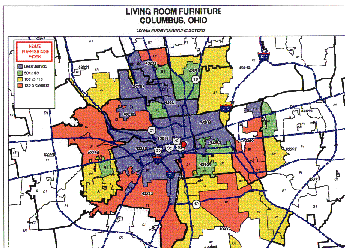Cost-effective shared mail.
It's a common mistake. Retailers spend precious time and money developing the perfect advertising layout, with meticulously crafted illustrations, colors and text, but often lose sight of the single most important factor in advertising: getting their ad into the hands of the right people. In fact, a Direct Marketing Association study shows that of all the factors influencing a consumer's response to an ad, including the ad design and offer, proper targeting accounts for 50 percent of the response rate.
This article, the third in a series on direct mail advertising, outlines the "how to's" of effective and efficient targeting. It focuses on shared mail, in which several advertisers' ads are combined in a single package. While highly targetable, this format is also very cost-effective because postage and other costs are shared among the advertisers. In short, shared mail represents a customized solution at an affordable price, delivering a better return on investment for your advertising dollar.
Step #1: Define Your Trading Area
Roughly 90 percent of your sales come from shoppers who live near your store. We refer to this area around your store as your "trading area." It follows that these are the consumers your advertising should target. Too often, though, retailers waste money by extending their advertising beyond their trading area. Or, they forego sales by missing pockets of high-potential consumers. Focusing your advertising within your unique trading area is critical to a successful direct mail campaign.
Think of your store as a "bullseye," around which you establish an appropriate perimeter to define the outer boundary for your mailing plan. We usually advise furniture retailers to use a 25-mile radius. This distance may be modified to account for the specific characteristics of your store, your customers and your competitors. For example, a very large store may warrant a larger radius, while a store with many competitors within 25 miles may choose a smaller radius.
Retailers who maintain a customer transaction database in which sales data can be broken down by ZIP Code can define their trading area with even more precision by selecting those ZIP Codes that generate the most per-household revenue.
As for the shape of your trading area, drawing a perfect circle around your store is a good starting point. However, the shape will likely change as you consider such things as competitors' locations, and barriers like bridges or highways which consumers are unlikely to cross to get to your store.

Step #2: Prioritize Your Trading Area
Not all consumers within the 25-mile radius are of equal value to you. As a general rule, the closer consumers live to your store, the higher their potential.
We recommend that you divide your trading area into three sub-areas - primary, secondary and tertiary - and develop an appropriate mailing plan for each. Your primary trading area will be the area immediately surrounding your store that accounts for the majority of your sales - roughly 65%. This is where you should focus the lion's share of your advertising resources. Secondary and tertiary areas will comprise approximately 15% and 10% of your sales, respectively. While clearly important to you, those areas further from your store should be considered lower priority in your mailing plan.
If you have a customer database, you can analyze geographic areas where your store generates the most revenue per household to determine your store's primary, secondary and tertiary trading areas. If you don't have a database, a good rule of thumb for furniture retailers is:
- Primary: 7 mile radius around your store.
- Secondary: 8-15 mile radius around your store.
- Tertiary: 16-25 mile radius around your store.
Step #3: Find Consumers with the Greatest Potential
Targeting your advertisements geographically, as described above, will take you a long way toward maximizing your ad dollars. But overlaying information about your shoppers onto your targeting plan can help you achieve an even better return on your advertising investment.
There are two primary sources of data that you can leverage: your customer database and companies that sell data.
Using Your Database
Creating and maintaining a customer database may appear daunting. However, many database consultants are available to help you develop a system that best meets your needs and budget. A good resource for identifying consultants in your area is the Direct Marketing Association (212/768-7277).
While an information-rich customer file can be of enormous help, you can develop sophisticated targeting plans with a database that simply captures your customers' ZIP Codes or street addresses. With this information, you can target the ZIP Codes or smaller geographic units that have a high proportion of your shoppers. If you also track sales by ZIP Code or by customer, you can select those ZIP Codes or sub-ZIP Codes that spend the most money at your store, and avoid those that don't.
Your database not only helps you identify your best customers, it can also help you find other high-potential consumers who "look" just like them. Here's how it works. Once you determine where your customers predominantly live, outside data can be applied to find out the primary demographic and lifestyle characteristics of consumers within those geographic areas. Working with a direct marketing consultant, you can then look at other geographic areas to find ZIP Codes or sub-ZIP Code areas with similar characteristics.
Using Syndicated Information
If you don't have a customer database, don't worry. Syndicated, or secondary, data sources that are for sale can also be excellent resources for a powerful targeting plan.
If you have a good general sense of the demographic make-up of your customers (e.g., their age, marital status, income, etc.), you can work with a direct marketer to determine where high concentrations of consumers matching this description live. For example, if your store sells upscale baby furniture, you might seek neighborhoods with large numbers of households where the occupants have higher incomes, are married and are in the 25-40 year-old age group.
In addition to demographic information, lifestyle data (such as hobbies and entertainment preferences) can help you target consumers even more precisely. After all, consumers who are similar in one regard may be very different in others. For example, among neighborhoods with families and mid- to upper-income levels, one neighborhood may be characterized by carpools, bikes and dogs. Another may be more urban and more focused on travel and cultural entertainment.
Arlington, VA-based Claritas, Inc. (703/812-2700) is an industry leader in providing lifestyle information. They have identified 62 lifestyle types with quirky names, such as Kids & Cul-de-Sacs and Money and Brains, into which similar consumers are grouped. These lifestyle clusters are then mapped by geographic region so that marketers can target specific consumer segments at the ZIP Code or even smaller levels. ADVO, for example, works with Claritas to target its shared mail program to consumer lifestyle clusters of on average only 3500 households each.
Another useful type of consumer targeting criterion is "purchase potential." Claritas, among other companies, has analyzed geographic areas nationwide to determine the inclination of consumers in those areas to buy certain products. You can use furniture purchase potential indices to select the best areas to target.
Because demographics, lifestyle and purchase potential are all important criteria for determining your best customers, it can be difficult deciding which to use. The good news is that you can use a combination of all of them by creating a "composite index" of your ideal consumer. To do this, you would identify the most important characteristics of your shoppers and then attach a weight to each characteristic that reflects its relative importance. You can then use shared mail to target those geographic areas that best match this composite index.
Step #4: Treat Different Customers Differently
The beauty of direct mail advertising is that you can treat your different customers differently - from the frequency with which you target them to the content of the ads themselves. No other media lets you target so precisely in such an effective and efficient manner.
Using the methods and tools described above, you can create a mailing plan for different consumer segments. For example, you may choose to advertise weekly to consumers in your primary trading area, monthly to those in your secondary trading area, and only occasionally, or for special events, to those in your tertiary area. You may also elect to reach on an ongoing basis only those ZIP Codes or sub-ZIP Codes within these areas with specific demographic or lifestyle characteristics. Or, you could advertise a special one-time sale in a particular department to a select group of consumers. Your options are virtually limitless.
Each furniture retailer has his or her own marketing opportunities and challenges. By working with a direct mail marketing consultant, you can customize a targeting solution that best works for you within your budget. The objective is simple: eliminate wasted coverage, while increasing advertising frequency to your current and prospective customers, in order to improve your advertising ROI.

At Home Designs, a high-end retailer in Columbus, Ohio, wanted to market its upscale living room sets. The targets for the advertisement were households with incomes above $60,000 in which the head of the household was between 35 and 54 years old and the house was owner-occupied. Based on At Home Design's knowledge of its customers, it believes that income is the most important criterion, with age a close second, and home ownership third.
After developing the composite index of these criteria, their primary trading area was analyzed. (7 miles around their store) for penetration of this "consumer profile." A color-coded map was developed to determine those sub-ZIP Code areas that best matched the profile and those that didn't. This map provided the retailer with an easy reference guide for selecting the best areas to mail its ad.
Sheila McCusker is Director, Strategic Business Development for ADVO, Inc., the nation's largest direct mail marketing company. In this capacity, she leads the Company's efforts to identify and leverage strategic growth opportunities within the media industry and the many retail and service industries ADVO serves.Questions on any aspect of direct mail marketing can be addressed to Ms. Mccusker care of FURNITURE WORLD Magazine at editor@furninfo.com.